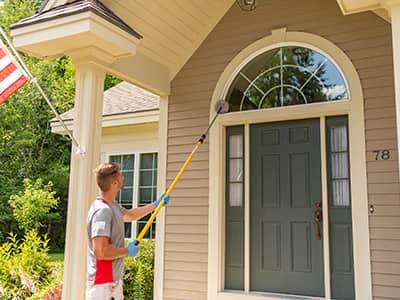May 03, 2022
What’s The Difference Between Carpenter Ants & Odorous House Ants?
Though we might wish otherwise, it’s quite normal to start seeing ants in your house and in your yard once spring arrives. After all, with warmer temperatures and increasing food sources as each spring day goes by, they’d be foolish to stay tucked away in some wall void or other hibernation site. If you’re one of the unlucky ones who have already found ants on the move inside your home or on your property but aren’t quite sure what kind of ant you’re dealing with, that’s okay. Pine State Pest Solution is here to help you identify and differentiate two of the most common types of ants in Maine – odorous house ants and carpenter ants.
Why ant identification is important
Does it really matter what kind of ant is in your home? While we understand you just want the ant problem cleared up, proper identification is a must. That’s because carpenter ants are wood-destroying insects that will create bigger issues for Maine homeowners than odorous house ants. Also, in order to successfully eradicate ant infestations, the right treatment is required but varies by ant species.
The most obvious difference between the two ants is their size
Carpenter ants enjoy a reputation for being big – at least bigger than other ants in Maine. The average worker in a carpenter ant nest measures a little more than half an inch in length. That’s considerably larger than odorous house ants that range in size from 1/16 – 1/8 of an inch in length.
Identifying carpenter ants and odorous house ants by their color
If you’re seeing large black ants (they may also look red, yellow, or a combination of red and black), odds are you’ve got yourself a carpenter ant nest somewhere close. Alternately, if you’ve spotted tiny dark brown to black ants moving about, it’s likely you have an odorous house ant problem.
Where they nest may give you a clue to what type of ant you’re dealing with
Carpenter ants actually have parent and satellite nests or colonies. As you can sort of guess by the name, a parent nest has one egg-laying queen, ant larvae and pupae (also known as brood), and large numbers of workers. Satellite nests do not house a queen and cannot reproduce.
They are typically located in tree cavities, stumps, logs, and in other water-damaged or decaying wood, or inside homes in areas prone to moisture and humidity. Since carpenter ants travel back and forth between the parent nest and satellite ones, they can establish the latter in wood that is not already harmed by moisture although they often are found there.
Common indoor carpenter ant nesting sites include, but are not limited to:
- Wall voids
- Support timbers & studs
- Sills & girders
- Insulation
- Window & door casings
- Porch pillars
An odorous house ant nest is made up of many reproducing queens and their subnests also house several queens that are able to reproduce. Odorous house ant nests are often located in soil and mulch as well as under rocks and firewood. Indoors, they’ll establish nests near moisture sources, including but not limited to:
- Wall voids
- Heaters
- Hot water pipes
- Leaking fixtures
Carpenter ants will damage your home, odorous house ants will not
Earlier we mentioned that carpenter ants are wood-destroying pests and this is an important distinction. Though not nearly as destructive as termites that live in other states, carpenter ants will start out by infesting water-damaged wood but then will move on to sound wood. When this happens and no treatment is performed, the end result is not favorable to the homeowner and there will be repairs needed in order to preserve the health of the house.
Odorous house ants, on the other hand, are nuisance ants. They’re annoying (especially when they show up in large numbers which is usually the case) and you may find them everywhere including in your food but they’re not a threat to health or property. Also, you might detect an unpleasant smell accompanying an infestation.
What to do if you find ants in the house
For effective ant control no matter the species, contact Pine State Pest Solutions at the very first ant sighting. Serving Auburn, Portland, and Augusta as well as communities throughout our multi-county service area, our locally owned and operated Maine pest control company will get rid of ants in your home and on your property after accurately identifying the pest, locating nests, and determining what conditions are attracting ants in the first place.
After completing a thorough inspection of your property, we’ll develop a plan of action that will eliminate your ant problem!
Home Protection Plan
Starting as low as $35/month*

Pine State’s Home Protection is an affordable pest control plan that is ideal for homeowners who want general pest control services that target common house-infesting insects and rodents.
When you sign up for this ongoing service, you’ll receive an initial service visit to treat the existing pest problem and then seasonal service visits spread out over the year to ensure pests stay out. That’s a total of four services annually.
Pests covered under Pine State’s Home Protection plan include carpenter ants, cornfield ants, crazy ants, field ants, little black ants, pavement ants, carpet beetles, cigarette beetles, drugstore beetles, flour beetles, ground beetles, hide beetles, larder beetles, saw-toothed grain beetles, warehouse beetles, boxelder bugs, carpenter bees, centipedes, clover mites, American cockroaches, brown-banded cockroaches, wood cockroaches, field crickets, house crickets, European earwigs, firebrats, bald-faced hornets, European hornets, deer mice, house mice, millipedes, Angoumois grain moths, drain moths, Indian meal moths, Mediterranean flour moths, mud daubers, Norway rats, paper wasps, pill bugs, rice weevils, silverfish, sow bugs, springtails, cellar spiders, daddy longlegs spiders, house spiders, jumping spiders, sac spiders, wolf spiders, Western conifer seed bugs, and yellow jackets.



 Subscribe
Subscribe